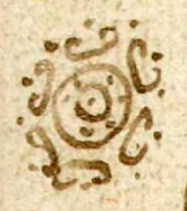Cuilol (TV4r)
This black-line drawing of the simplex glyph for the personal name Cuilol ("A Painting" or "Painter” attested here as a man’s name) shows two, dotted concentric circles and, around the perimeter, six curling lines and more dots. The verb, icuiloa (or ihcuiloa, with the glottal stop), means to write or paint, and this name ends in -lol, which has a nod to the nominal suffix or absolutive (-lli). Cuilol can therefore call to mind cuilolli, icuilolli, and tlacuilolli (a piece of writing, a painting, a design carved in stone, etc.). The initial i- of icuiloa has also dropped away, but this is not unusual. The -cuil- root refers to something curved or curvy, and this glyph certainly has that. When not referring to painting or writing, the cuil root can refer to other design expressions, such as embroidery, stone sculpture, and even the cultivation of the earth.
Stephanie Wood
See below for another example of Cuilol, which seems to show two frames of a screen-fold codex with flower or rosette symbols that Gordon Whittaker (personal communication) identifies with the verb (i)cuiloa, to paint or write. Our iconographic example of tlacuiloliztli shows this same flower in addition to the two speech scrolls pointing opposite ways, as though in conversation. That example, from the Codex Telleriano Remensis, shows a woman actively painting or writing on that two-screen codex.
Penny C. Morrill translates the name "Cuillol" as "Painter" in her book, The Casa del Deán (2014, 89).
Marc Thouvenot identifies the verb icuiloa (or ihcuiloa, with the glottal stop), which means to paint, write, or print, as having a root of -cuil-. He notes how it also appears in tlacuiloliztli (writing), tlacuilo (writer), and cuicuiltic (mottled). He goes on to show various uses of icuiloa that take it beyond the simple definitions just given, resulting in something like the action of creating a design (e.g., on leather, ceramics, sculpture, or in textiles). It can also be something like the action of decorating (e.g., to put a flower on a cup of atole). He associates icuiloa and tlacuilolli with "cultural artifacts," such as arts and crafts or examples of writing and painting, but cuicuiltic with effects created by "nature." This short summary barely does his article justice; it is worth reading the entire piece. How Thouvenot's study might connect with the concept of bent or curved mentioned by Prem (1974: 555, 682) raises an interesting question. Perhaps the bent or curved lines of writing, painting, carving, embroidery, and so on, fall with in the realm of expressions of -cuil-. See
Marc Thouvenot, "Imágenes y escritura entre los nahuas del inicio del XVI," Estudios de Cultural Náhuatl 41 (2010).
Stephanie Wood
miguel cuilol
Miguel Cuilol
Stephanie Wood
1574
Jeff Haskett-Wood
escribir, pintar, escribiendo, pintando, escrituras, codices

Cuilol, a name, https://nahuatl.wired-humanities.org/content/cuilol
cuilol(li), a painting or a manuscript, https://nahuatl.wired-humanities.org/content/cuilolli
icuilol(li), a painting or a manuscript, https://nahuatl.wired-humanities.org/content/icuilolli
tlacuilol(li), a piece of writing or a painting, https://nahuatl.wired-humanities.org/content/tlacuilolli
Pintura o Escritura
Stephanie Wood
El Libro de los Tributos de San Pablo Teocaltitlan, also known as the Codex Valeriano and Manuscrit Mexicain 376, is hosted by the Bibliothèque nationale de France, published on line in the digital resource, Gallica, https://gallica.bnf.fr/ark:/12148/btv1b8455947h/f15.item.r=Libro%20de%20...
The non-commercial reuse of images from the Bibliothèque nationale de France is free as long as the user is in compliance with the legislation in force and provides the citation: “Source gallica.bnf.fr / Bibliothèque nationale de France” or “Source gallica.bnf.fr / BnF.” We would also appreciate a citation to the Visual Lexicon of Aztec Hieroglyphs, https://aztecglyphs.wired-humanities.org/.




